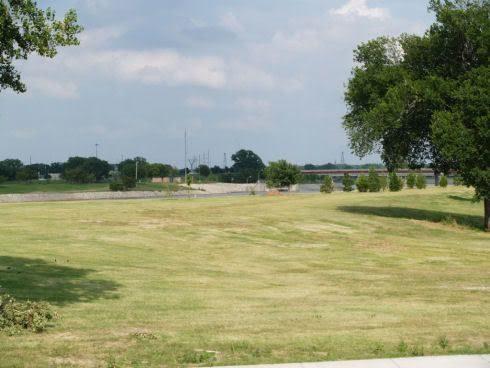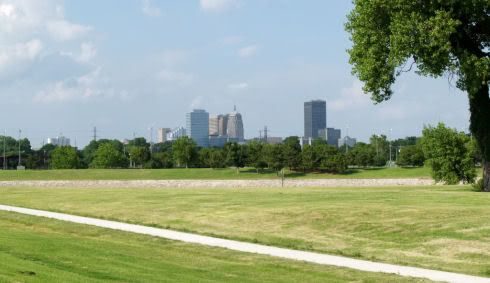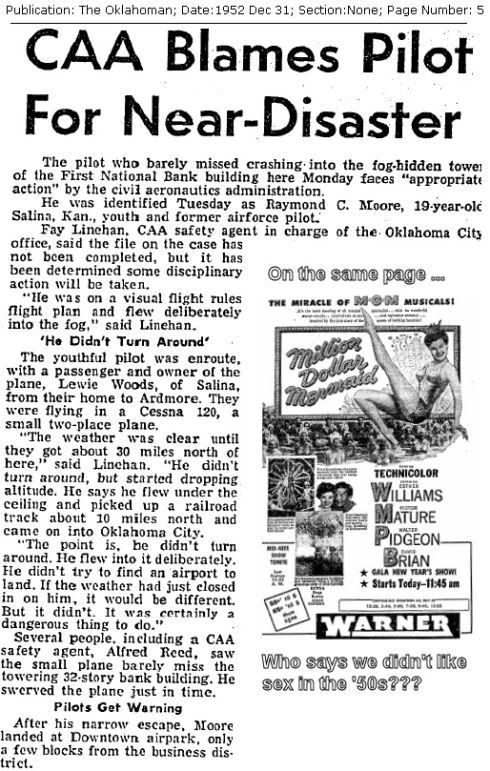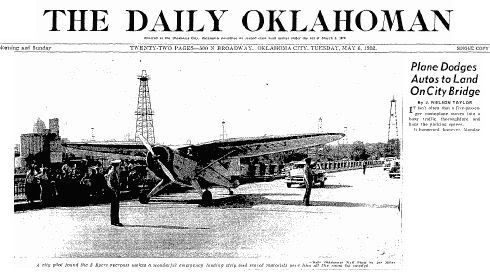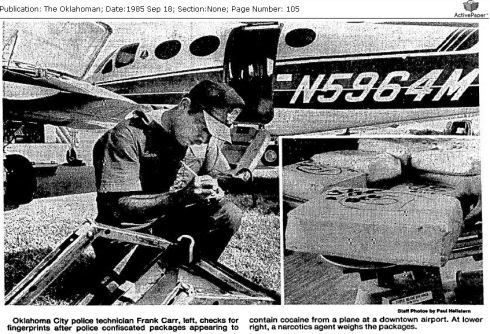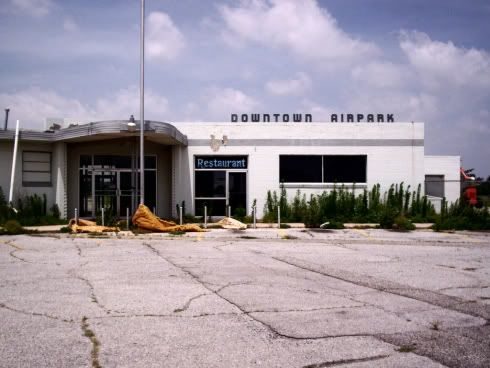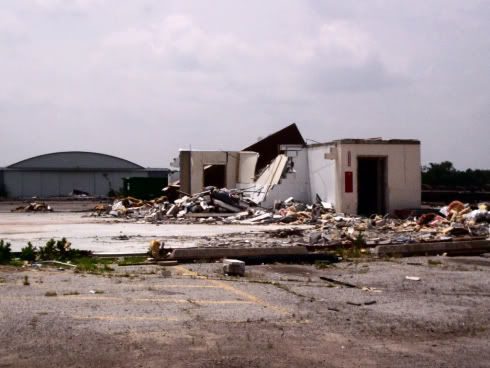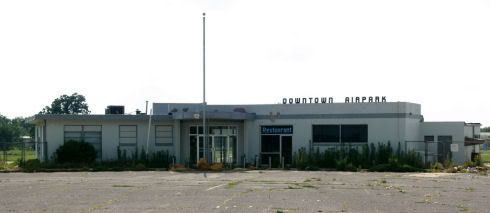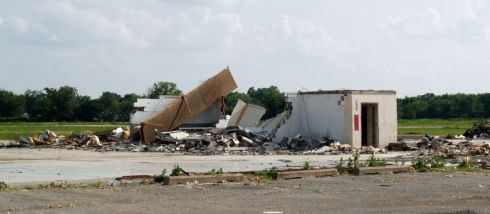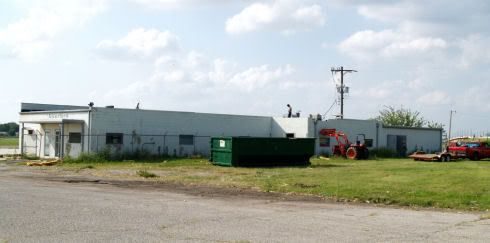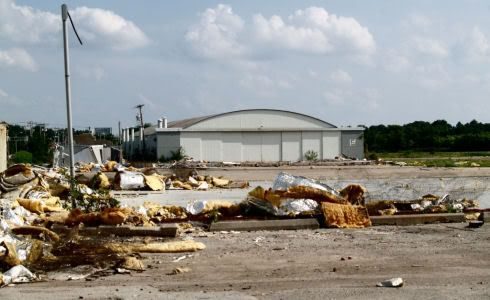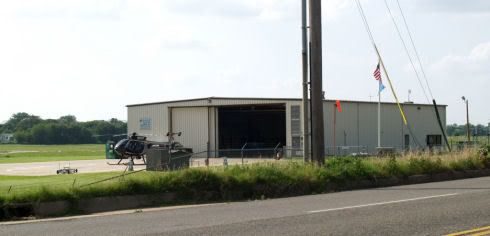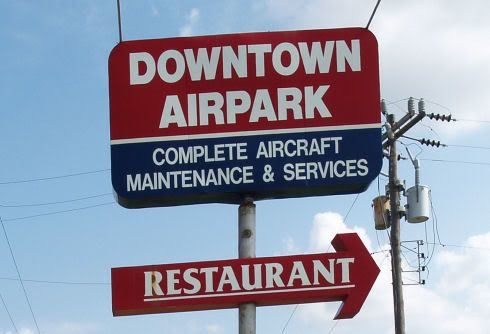
The Downtown Airpark, located a short distance from downtown, was born July 4, 1947, and died, as an airpark, on or about June 1, 2005.
A map showing the location and another Google image showing the facility a few years back appear below.
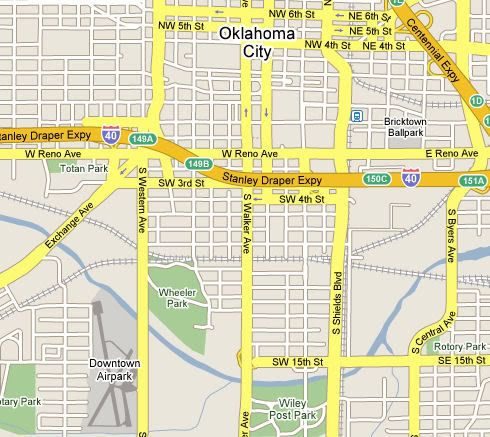
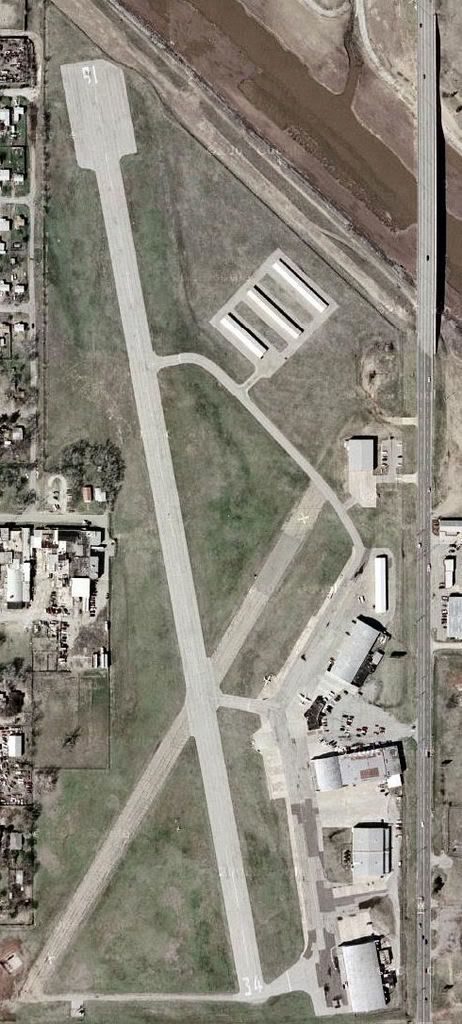
The pics below were taken on June 9, 2007, and show the airpark’s proximity to the Oklahoma River and downtown.
Looking Easterly Along the Oklahoma River
Looking Northeast Towards Downtown
A 2005 image from an Oklahoman article
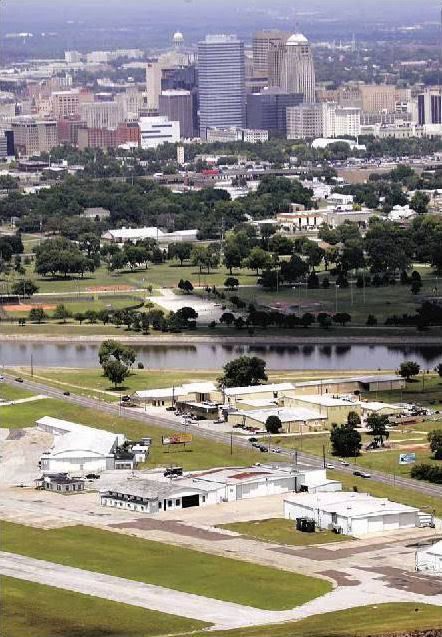
GRAND OPENING. Begun by W.D. “Bill” Amis, Dean A. McGee, Hudgins-Thompson-Ball Associates, OG&E, and several other investors, the airpark was located at 1701 S. Western on the south bank of what is now the Oklahoma River, the airpark was merely a skip to downtown, evident from the last pictures shown above. The area was not even within Oklahoma City’s limits until some time in 1959, a proposal to annex it having failed in 1956. Upon it’s opening, it was declared to be a “pioneer” for privately owned airport facilities. According to a July 25, 1946, Oklahoman article,
The only other large city in the nation with landing facilities in the downtown section of [is] Indianapolis, which has a single strip. Cleveland, Ohio, is in the process of constructing a landing field on the downtown lakefront that will be within a few minutes of the business section.
Actually, the Oklahoma City airpark is the first experiment to determine if such a landing field is a practical investment for private capital, aviation leaders say.
For more than 50 years, apparently it was. The airpark served as a landing field for aircraft as small as single engine planes and as large as the venerable Douglas DC-3. As well, it served as the home of several aircraft service facilities, for many years being a major service center for Aero Commander aircraft of various vintage.
Oklahoman articles anticipated the grand opening. Click the images below for larger images (as with most others in this post) …
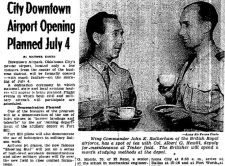
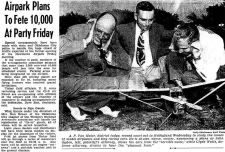
10,000 visitors were expected for the fanfare but the Oklahoman reports that only 3,500 or so showed up to witness, among other things, a fly-by of the venerable (but then state of the art) Lockheed P-80, the first jet plane brought into the Army Air Force’s arsenal (officially, in 1945, shortly before the end of World War II). An Oklahoman article showing the fly-by and a couple of images showing the aircraft are shown below – no larger pics below are available.
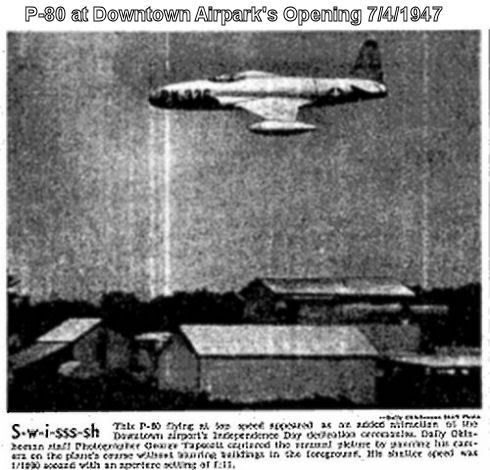
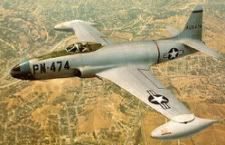
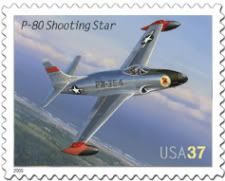
DURING ITS HEYDAY. As one might expect from a small privately owned airport (and, of course, all of the following occurred before the “post 9-11” developments which pushed airport security into the foreground), lots of interesting things occurred at or associated with the airpark, ranging from the airpark itself to associated honest misadventures to dishonest drug smuggling.
The Airpark Itself. Facilities-wise, the small airpark was neither large nor pretty – the words “utilitarian” and “functional” come to mind. I’ve not yet located any close-up images of the airpark during its heyday, but when I find them I’ll edit this post. A July 28, 1995, Oklahoman article described the small terminal building as “vaguely art deco,” which was perhaps being generous – check out the current day demolition photos, below, and form your own opinion. As to the restaurant (which operated from 1954 through 2005), the article said that, “The restaurant at the north end [of the terminal], with its blue vinyl booths and wobbly pedestal tables, serves grilled hamburgers and fries and chicken fry with mashed potatoes and fried okra.”
Its original concept endured throughout its life – to provide a place for owners of privately owned aircraft to lease space, provide flight training, aircraft charter service, storage and maintenance. It became a full service facility, and housed a major service center for Aero Commander aircraft. It came to include 5 large hangars, many more small hangars, and an administration / terminal building which included a restaurant. A July 11, 1987, Oklahoman article said that the airpark claimed to have the largest Commander parts inventory in the world. A November 4, 1976, Oklahoman article bore the headline, “World Flies Into ‘Small-Town’ Airpark’.” In the article:
The small privately owned airpark does an annual business totaling more than $2 million, reports Ray Wilson, General Manager. “Most of our business comes from out of Oklahoma,” Wilson said. Aircraft are flown in for modification from practically every state in the nation and many foreign countries.
Right now the airpark is converting a North American Rockwell 690A turboprop into a photographic plane for a department of the United Nations in Geneva, Switzerland. “They’re going to use it to take infrared photographs of opium fields in Turkey,” Wilson said.
* * *
The airfield, which is in the shadow of downtown buildings, is also a distributorship for Aero Commander aircraft.
* * *
For a number of years, the airpark has had contracts with the manufacturers of small aircraft and with the U.S. Department of Defense to install interior trim, radio and electronic equipment and to paint the exterior of planes.
The airpark’s connection with Aero Commander was significant enough for it to host a reunion in 1995. A June 16, 1995, Oklahoman article reported that, “Dozens of venerable twin-engine ‘Aero Commander’ aircraft – a line born in Bethany in 1952 – are expected as far away as Germany, Australia and Sweden for the inaugural meeting of the ‘Twin Commander Flight Group’ today at Downtown Airpark. * * * Defense attorney F. Lee Bailey, also a twin-Commander flier, is expected for the gathering.” The article notes that W.D. Amis was an original investor in the Aero Commander company.
Side Note: A September 10, 2005, Oklahoman article said that Commander Aircraft was leaving the state. For a fuller discussion about that which includes some discussion of the airpark, see this article, in PDF format.
In a 1955 Oklahoman article, it was said that of the 300 private planes then said to be owned by Oklahoma Citians, 100 of them were housed in the Downtown Airpark. A June 1, 2005, Oklahoman article by Steve Lackmeyer and Julie Bisbee said that in the mid-1990s the airpark employed more than 140 people. The article notes that even as late as the March 2003-March 2004 twelve-month period, 7,500 landings and takeoffs were recorded.
The airport runways proved easily large enough to handle the venerable DC-3s, for many years the mainstay in commercial aircraft. In 1948, the airpark was certified to handle them. Credit the Oklahoman, November 14, 1948, for the pic taken at the airpark, below.
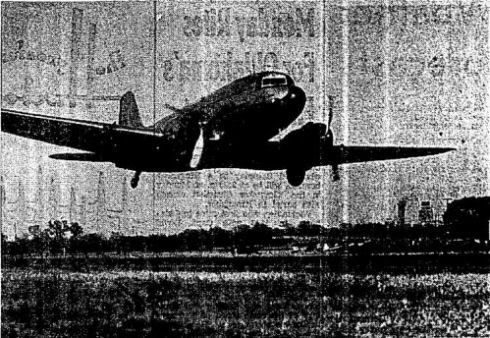
Eventually, the airpark was owned by various members of the Amis family and Kerr-McGee, and, later, only by the Amis family.
Other Interesting Happenings. The Oklahoman’s archives include lots of anecdotal stories associated with the airpark, ranging from kids taking off from there (without permission), to one-wheel landings, to a forced landing on Byers Avenue after taking off from the airpark, to a near collision with the First National Bank, to liquor (during prohibition days) and drug busts, and some crashes.
Perhaps the 1st “interesting” event was reported was contained in an August 4, 1949, Oklahoman article which reported that, “Harold Byford, Oklahoma City bootlegger, has admitted to CCA officials that he has been hauling liquor into Oklahoma a transport plane-load at a time, using his DC-3 to do so. His plane was based at the Downtown Airpark, although the article says that Harry Reed, manager of the airpark, denied that the plane brought whisky into his airport. The article noted that, “The shiny plane is based at the Downtown Airpark. Where it picks up its load or the point where it is unloaded in the state, however, is still a mystery. It could land at any number of little used fields in many parts of the sate with little chance of it being seen.”
A few other anecdotal events are shown below … all are credited to the Oklahoman …
Nearly Collides With the 1st National Bank
A 1952 Forced Landing On Byers Avenue After Takeoff
A 1985 Drug Bust Netting 500 Pounds of Cocaine
An April 25, 1991, Oklahoman article notes that the federal Drug Enforcement Agency (DEA) seized $1.43 million from Gulfstream Aerospace Corp., 7400 NW 50th Street, relating to Columbian Jose Manzanera who was said to have used his aircraft to transport cocaine, several of his flights having used Downtown Airpark.
In April 1985, Mayor Andy Coats proposed that the airpark be acquired by the city via condemnation or other procedures and that it, and Wheeler Park, become the site of a new racetrack facility to go hand-in-glove with the “String of Pearls” project. The Oklahoman editorialized that it liked the idea.
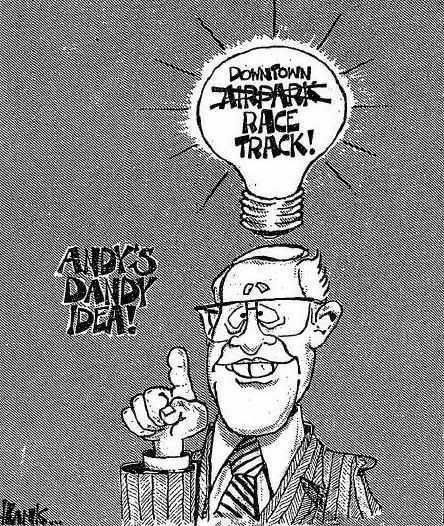
But, of course, that didn’t happen – Remington Park came to exist in the northeast part of town on Martin Luther King Avenue, instead.
END OF THE TRAIL & FUTURE PROSPECTS. A June 2, 2005, Oklahoman article, “Left on the Ground,” described the beginning of the end. The airpark closed the day earlier, the owners (members of the Amis family) telling employees “not to come back.” The article quotes Dave Amis III, grandson of co-founder W.D. Amis, as saying, “We tried to stick it out [after the 9/11 terrorist attack in New York City], and we made a gallant go of it.” Airplane owners storing their planes there were sent looking for new space, even though landings and takeoffs continued for a time – but without refueling there. Amis said, “This has been quite a 48 hours for my dad and me. This business has been in our family for 58 years. We’re just sitting back taking a breather and no making a decision when we are emotional and stressed.”
Some interest existed by the Seminole Tribe in acquiring the property to make it a casino, but in a November 19, 2005, Oklahoman article, the tribe’s chief, Kelly Haney, described the notion as “far fetched.” In any event, that didn’t happen.
A December 8, 2005, Oklahoman article documents that the airpark was placed in receivership after accumulating more that $1.5 million in debt (but see the quote below as to amount) and that various items of real and personal property owned by the airpark were to be sold for public auction. In a January 7, 2006, Oklahoman article, Julie Bisbee and Steve Lackmeyer noted that,
Speculators interested in turning the acreage of a defunct airpark into a riverfront development got a nod Friday from a state judge overseeing the foreclosure case of the Downtown Airpark. ¶ Judge Daniel Owens approved a motion that allows prospective buyers to make bids on the 80.6 acres of land just west of downtown Oklahoma City to help pay off the debts of Downtown Airpark Inc. ¶ The corporation owes more an $5 million to creditors. * * *
The article said that more than $193,000 was owed to employees when the airpark closed. It also identified several interested bidders, including former Oklahoma City mayor Kirk Humphreys and his sons Grant and Blair. The article concludes,
Jim Hasenbeck, a partner with Studio Architecture who did the master plan for the Oklahoma River, has said that the airpark site is a prime development spot because of its view of the downtown skyline and proximity to the new Interstate 40 Crosstown Expressway.
Finally, after initiating the purchase in February 2006, the property was acquired by Aduddell-Humphreys Partners for $7.2 million in November 2006, according to a November 11, 2006, Oklahoman article. The article said that the “partnership” also included the Jim Brewer family and others.
Similar to a February 3, 2006, Oklahoman article by Steve Lackmeyer, a November 30, 2006, article in the Journal Record opined about the new owners’ options:
Several options for the land have been discussed, including diverting the Oklahoma River to possibly establish shoreline. ¶ Grant Humphreys has, however, said the property will be held for three to five years while Interstate 40 is realigned and a master plan is established. ¶ Some of the uses the new owners have suggested include a mixed- use development as well as the possibility of a restaurant row and hotel.
On a more personal level, despite the airpark’s closure, the restaurant it housed lingered on for a time. An August 6, 2005, Oklahoman article described the plight of Lundy’s Restaurant:
The café, which has shared building space with the Downtown Airpark for nearly 51 years, is still hanging on while the air airpark faces foreclosure. * * * ¶ But [Kay] Lundy plans to stay on until she’s forced to shut down the restaurant.. * * * ¶ Lundy’s mother, Iva, started the restaurant at the Downtown Airpark when business in the area was bustling. She redesigned the restaurant * * * to include a counter so workers who only had 30 minutes for lunch could get their food quicker. ¶ Working in restaurants is all Lundy has known. She started working in her mother’s restaurant at 12 and went on to work at Cattlemen’s restaurant before coming back to run her mother’s restaurant when she retired.
A nice pic of the restaurant founder’s daughter during its last days of operation appeared in the same Oklahoman article, taken by Oklahoman photographer Doug Hoke, below.
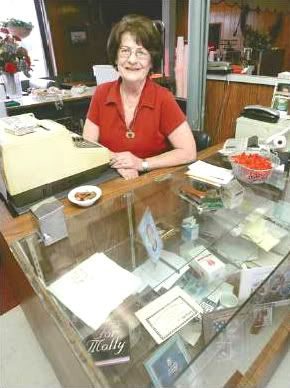
Survival for Lundy’s was not to be. The restaurant’s properties were auctioned off on January 30, 2007.
As far as I know, nothing much has happened since, other than the dismantling of buildings located at the airpark. The pics below were taken about 7-10 days ago, some by me and some by my friend Keith Sossamon (the first two). In the pics, if you look closely and tweak your imagination just a little, you might get a glimpse of what once was but is no more.
By Keith – General Destruction
Pics by Me
The Terminal, Restaurant at the Right
Looking Northwest
Not Yet Gone, But Going
Looking South
The Sole Surviving Remnant
OCPD Helicopter Facility
What Will Come of this Great Location?

If the statements (prophesies, perhaps) in the February 2, 2006, Oklahoman, are and will become true, it will be good even if radically different than the airpark’s past. These things were said:
“We became interested in the property because of its great views of the downtown skyline and prime riverfront location,” Aduddell said. “It’s by far the biggest single development site in close proximity to downtown.” ¶ Grant Humphreys said they envision a mixed-use master-planned development that could include offices, housing, hotels and retail. He said a master planner will be hired within the next year. ¶ * * * [Blair Humphreys said] “This will build on the success of MAPS and be another boost to the momentum of downtown Oklahoma City.”
So we all hope, as we all watch and wait.

